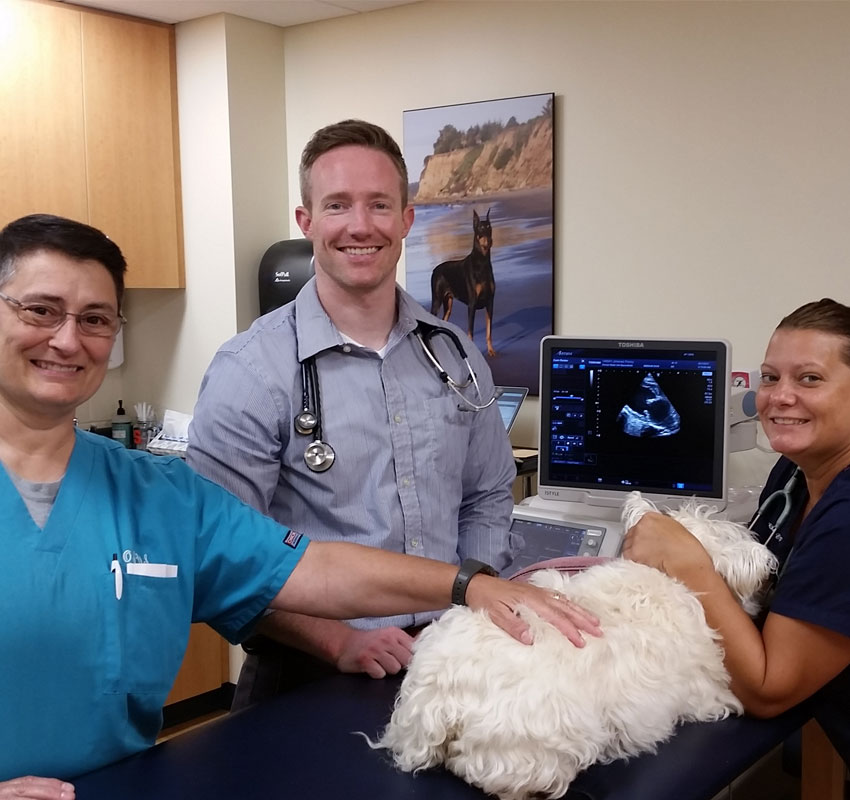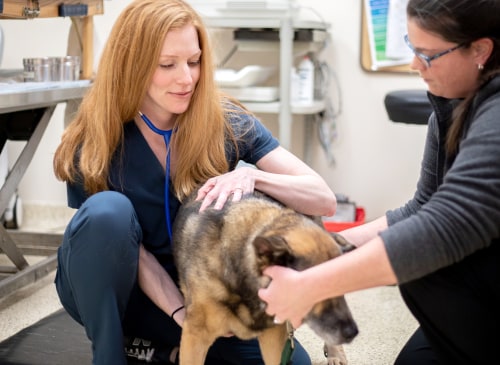Benefits of Early Diagnosis With a Board Certified Veterinary Cardiologist}
Wiki Article
What You Need to Understand About Vet Services: An Introduction of Diagnostic Equipments and Procedures
Veterinary services play a vital duty in preserving the wellness of family pets. Routine exams can disclose hidden health and wellness problems beforehand. Various analysis tools and treatments, such as blood tests and imaging methods, supply essential understandings into an animal's wellness. Comprehending these techniques is essential for animal owners. What specific diagnostic procedures are most generally utilized, and just how can they affect an animal's treatment plan?Relevance of Routine Vet Exams
While numerous family pet proprietors might take too lightly the importance of routine vet examinations, these consultations are necessary for keeping an animal's overall health and wellness. Routine sees to the vet permit very early discovery of prospective health concerns before they escalate right into significant issues. Routine check-ups usually include vaccinations, which are necessary for preventing contagious conditions that could significantly impact a pet dog's well-being. Additionally, these consultations give an opportunity for vets to examine the pet's weight, dental wellness, and overall problem, making sure that the family pet is thriving. During these sees, pet owners can also get valuable suggestions on diet regimen, exercise, and preventive treatment tailored to their specific animal's needs.Typical Diagnostic Treatments in Vet Medication
In veterinary medication, exact medical diagnosis is important for effective treatment. Typical analysis treatments include blood testing techniques, progressed imaging technologies, and urinalysis, each playing a significant duty in identifying health issues. Understanding these methods boosts the capability to provide ideal care for animal clients.Blood Examining Techniques
Blood testing techniques function as crucial analysis devices in veterinary medicine, making it possible for veterinarians to assess the health and wellness of pets accurately. These strategies involve accumulating blood samples to assess various parts, such as red and white blood cells, platelets, and biochemical pens. Typical examinations consist of total blood counts (CBC), which assess overall health and wellness and spot infections, and biochemical panels, which evaluate organ function and metabolic condition. Additionally, serological tests can identify details diseases via antibody discovery. Blood screening is minimally intrusive and supplies essential information that assists in detecting conditions, monitoring wellness condition, and assessing reactions to therapies. In general, these strategies play a crucial function in making certain optimal look after family pets and livestock alike.Imaging Technologies Utilized
Analysis imaging innovations are important tools in veterinary medication, matching blood screening strategies by supplying visual insights into a pet's interior structures. Typical imaging techniques consist of X-rays, which work for reviewing bone fractures and detecting foreign things, and ultrasound, which enables real-time visualization of soft tissues and body organs. Magnetic vibration imaging (MRI) provides detailed pictures of intricate anatomical locations, specifically in neurological evaluations. Calculated tomography (CT) supplies cross-sectional images, boosting diagnostic precision for numerous problems. Each of these technologies aids vets in detecting ailments, intending therapies, and keeping track of healing. By including imaging modern technologies, veterinary professionals can better examine an animal's health and wellness and make educated decisions regarding their care.
Urinalysis and Diagnostics
Urinalysis offers as a vital diagnostic device in veterinary medicine, giving important insights into a pet's total wellness and assisting in the discovery of various conditions. This non-invasive procedure examines pee samples to assess kidney function, hydration condition, and metabolic disorders. Common components examined include specific gravity, pH levels, glucose, proteins, and the existence of blood or bacteria. Unusual searchings for can suggest problems such as urinary system tract infections, diabetic issues mellitus, or kidney illness. To improve analysis accuracy, urinalysis is often done in conjunction with other examinations, such as blood job and imaging studies. Early detection through urinalysis can cause timely treatments, enhancing the prognosis for numerous vet clients. It is an important element of detailed vet treatment.Comprehending Blood Examinations and Lab Analysis
Comprehending blood examinations and lab analysis is vital in vet medicine as it helps in diagnosing numerous health and wellness problems in animals. Various kinds of blood tests offer crucial info regarding a pet's internal state, while analyzing lab results needs mindful factor to consider of many aspects. This area will certainly explore the types of blood examinations available and the significance of their outcomes.Kinds Of Blood Examinations
Blood tests play a crucial duty in vet medicine, supplying crucial understandings into an animal's wellness status. Numerous kinds of blood tests are utilized, each serving different objectives. Total blood counts (CBC) examine total health and spot conditions such as anemia or infection. Biochemical accounts assess body organ function by measuring enzymes and electrolytes, supplying insights into metabolic health. Serological tests determine specific antibodies or virus, aiding in the medical diagnosis of infections or autoimmune diseases. Blood keying guarantees secure transfusions, while coagulation tests assess the blood's ability to embolisms, crucial for surgeries. These examinations collectively improve medical diagnosis, therapy planning, and tracking of an animal's health and wellness, highlighting the importance of complete lab evaluation in vet care.
Interpreting Laboratory Outcomes
A detailed analysis of laboratory outcomes is necessary for accurate diagnosis and treatment in veterinary medication. Interpreting laboratory results needs an understanding of normal referral varieties and the importance of deviations. Blood examinations can disclose different health signs, such as organ feature, electrolyte balance, and the existence of infections. Veterinarians need to take into consideration the whole scientific photo, consisting of the animal's history, physical exam findings, and any type of signs and symptoms provided. Variants in outcomes might arise from factors such as age, breed, and underlying wellness problems. Laboratory outcomes need to not be watched in isolation however instead as part of an all-inclusive diagnostic approach. Accurate analysis permits tailored therapy plans and far better end results for vet clients.Imaging Techniques: X-rays, Ultrasounds, and Beyond
Imaging methods are important tools in veterinary medicine, giving vital understandings right into the wellness and wellness of animals. Among one of the most generally utilized techniques are X-rays and ultrasounds. X-rays are very useful for imagining bone structures, assisting vets identify fractures, growths, or foreign items. This approach is fast and non-invasive, making it perfect for immediate situations.Ultrasounds, on the various other hand, utilize sound waves to create pictures of soft tissues and body organs. This method is particularly useful for checking out the heart, abdominal area, and reproductive body organs, allowing veterinarians to examine problems like liquid buildup or body organ abnormalities.Beyond X-rays and ultrasounds, progressed imaging Our site strategies such as computed tomography (CT) and magnetic resonance imaging (MRI) are significantly made use of in vet method. These methods provide in-depth cross-sectional pictures, improving the accuracy of medical diagnoses and therapy plans. Ultrasound For Dogs. Overall, imaging techniques play an important role in making sure efficient vet careThe Role of Biopsies in Diagnosing Family Pet Health And Wellness Issues
Precision in identifying health and wellness concerns in animals typically pivots on making use of biopsies, which provide definitive info regarding tissue abnormalities. A biopsy entails the elimination of a tiny example of cells for examination under a microscope, enabling vets to recognize numerous problems, consisting of infections, growths, and inflammatory illness. This analysis device is vital for comparing deadly and benign growths, assisting treatment decisions, and assessing the seriousness of a condition.Biopsies can be performed making use of numerous techniques, such as needle goal, incisional biopsies, or excisional biopsies, depending on the place and sort of cells entailed. The choice of technique might influence healing time and the amount of cells accumulated. Inevitably, the info amassed from a biopsy can result in targeted treatments, enhancing end results for pet dogs dealing with significant health and wellness challenges. Veterinarians highlight the value of this treatment in attaining precise medical diagnoses and effective treatment strategies.Advanced Diagnostic Equipment: Endoscopy and CT Scans

Advanced analysis tools, such as endoscopy and CT scans, play an important duty in modern veterinary medicine, providing non-invasive techniques to imagine internal frameworks and diagnose numerous problems in animals. Endoscopy entails using a flexible tube furnished with a camera, allowing vets to check out the gastrointestinal system and breathing system directly. This strategy can disclose problems such as lumps, foreign bodies, or swelling, allowing targeted therapy plans.CT scans, on the other hand, use sophisticated imaging technology to create comprehensive cross-sectional photos of the body (Cancer Veterinary Near Me). This method is specifically useful for assessing facility frameworks like the brain, spinal column, and joints. By giving high-resolution images, CT scans assist veterinarians in determining issues that might not appear with traditional radiography. Together, these advanced tools boost diagnostic accuracy, improve therapy outcomes, and ultimately add to much better general family pet health administration

Analyzing Test Results: What Pet Dog Owners Need To Know
Understanding examination results can be a difficult job for pet dog owners, particularly after innovative procedures like endoscopy and CT scans have actually been performed. Analyzing these outcomes requires a grasp of clinical terminology and a clear understanding of what the searchings for show about the animal's health. Vets usually supply descriptions, yet the intricacy of the outcomes can still bring about confusion.Pet proprietors should proactively take part in discussions with their veterinarians, asking inquiries to clarify any unpredictabilities. It is necessary to comprehend uncommon versus normal results and the implications for the pet dog's therapy strategy. Furthermore, identifying that some outcomes may call for additional testing or surveillance can assist owners stay informed about their pet's health and wellness journey. Eventually, a collaborative approach in between pet dog owners and veterinary professionals cultivates better health and wellness end results and improves the general care experience for family pets.Often Asked Concerns
Just how Do I Pick the Right Veterinary Center for My Animal?
additional resources Selecting the best veterinary facility includes researching neighborhood alternatives, assessing qualifications, checking out facilities, and assessing personnel interactions (Ultrasound For Dogs). Prioritizing recommendations from trusted sources can assist ensure the very best care and atmosphere for a family pet's health and wellness requirementsWhat Should I Do if My Pet Declines to Go to the Veterinarian?
When a pet dog refuses to head to the veterinarian, it's advisable to remain calm, usage deals with or playthings to lure them, and consider scheduling a home see if stress and anxiety persists. Patience and positive support are essential.Are There Telehealth Options for Veterinary Services?
Telehealth choices for veterinary services are increasingly offered, allowing animal proprietors to seek advice from veterinarians remotely. These solutions allow discussions about health and wellness worries, suggestions on small conditions, and follow-ups without needing to see a center.
How Commonly Should My Animal Have Oral Examinations?
The regularity of oral check-ups for pet dogs normally depends upon their age and breed. Typically, vets advise yearly oral evaluations, although some animals might require more frequent sees to keep excellent dental health and wellness.
What Are the Expenses Related To Vet Diagnostics?
The prices connected with veterinary diagnostics can differ commonly, commonly varying from standard examinations like blood job to advanced imaging strategies. Variables influencing expenses include the clinic's area, tools utilized, and particular examinations needed for every pet dog. Vet solutions play an essential function in maintaining the health of pets. While numerous animal proprietors might ignore the importance of routine vet check-ups, these consultations are essential for Read Full Report keeping an animal's general wellness. Additionally, these visits supply a chance for vets to examine the animal's weight, dental wellness, and total problem, ensuring that the animal is thriving. Precision in diagnosing health concerns in animals often pivots on the use of biopsies, which supply definitive information about tissue irregularities. Furthermore, acknowledging that some outcomes may require more screening or surveillance can help owners remain notified about their family pet's wellness trip.Report this wiki page